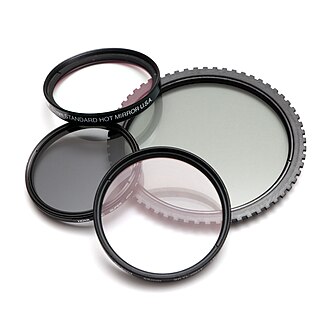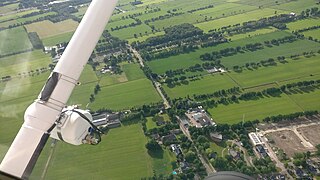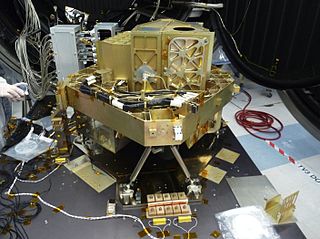
The Lockheed AC-130 gunship is a heavily armed, long-endurance ground-attack variant of the C-130 Hercules transport fixed-wing aircraft. It carries a wide array of anti-ground oriented weapons that are integrated with sophisticated sensors, navigation, and fire-control systems. Unlike other military fixed-wing aircraft, the AC-130 relies on visual targeting. Because its large profile and low operating altitudes make it an easy target, it usually flies close air support missions at night.

An optical mouse is a computer mouse which uses a light source, typically a light-emitting diode (LED), and a light detector, such as an array of photodiodes, to detect movement relative to a surface. Variations of the optical mouse have largely replaced the older mechanical mouse design, which uses moving parts to sense motion.

The Large Binocular Telescope (LBT) is an optical telescope for astronomy located on 10,700-foot (3,300 m) Mount Graham, in the Pinaleno Mountains of southeastern Arizona, United States. It is a part of the Mount Graham International Observatory. The LBT is currently one of the world's most advanced optical telescopes; using two 8.4 m (330 inch) wide mirrors, with centres 14.4 m apart, it has the same light-gathering ability as an 11.8 m (464 inch) wide single circular telescope and detail of a 22.8 m (897 inch) wide one. Its mirrors individually are the joint second-largest optical telescope in continental North America, behind the Hobby–Eberly Telescope in West Texas; it is also the largest monolithic, or non-segmented mirror, in an optical telescope. Strehl ratios of 60–90% in the infrared H band and 95% in the infrared M band have been achieved by the LBT.

Forward-looking infrared (FLIR) cameras, typically used on military and civilian aircraft, use a thermographic camera that senses infrared radiation.

A thermographic camera is a device that forms a heat zone image using infrared radiation, similar to a common camera that forms an image using visible light. Instead of the 400–700 nanometre range of the visible light camera, infrared cameras operate in wavelengths as long as 14,000 nm (14 µm). Their use is called thermography.

Goalkeeper is a Dutch close-in weapon system (CIWS) introduced in 1979. It is an autonomous and completely automatic weapon system for short-range defence of ships against highly maneuverable missiles, aircraft and fast maneuvering surface vessels. Once activated the system automatically undertakes the entire air defense process from surveillance and detection to destruction, including selection of the next priority target.

Infrared thermography (IRT), thermal imaging, and thermal video are examples of infrared imaging science. Thermographic cameras usually detect radiation in the long-infrared range of the electromagnetic spectrum and produce images of that radiation, called thermograms. Since infrared radiation is emitted by all objects with a temperature above absolute zero according to the black body radiation law, thermography makes it possible to see one's environment with or without visible illumination. The amount of radiation emitted by an object increases with temperature; therefore, thermography allows one to see variations in temperature. When viewed through a thermal imaging camera, warm objects stand out well against cooler backgrounds; humans and other warm-blooded animals become easily visible against the environment, day or night. As a result, thermography is particularly useful to the military and other users of surveillance cameras.

In photography and cinematography, a filter is a camera accessory consisting of an optical filter that can be inserted into the optical path. The filter can be of a square or oblong shape and mounted in a holder accessory, or, more commonly, a glass or plastic disk in a metal or plastic ring frame, which can be screwed into the front of or clipped onto the camera lens.

The Lockheed CP-140 Aurora is a maritime patrol aircraft operated by the Royal Canadian Air Force. The aircraft is based on the Lockheed P-3 Orion airframe, but mounts the electronics suite of the Lockheed S-3 Viking. "Aurora" refers to the Roman goddess of dawn who flies across the sky each morning ahead of the sun. Aurora also refers to the Aurora Borealis, the "northern lights", that are prominent over northern Canada and the Arctic Ocean.

The Stratospheric Observatory for Infrared Astronomy (SOFIA) is an 80/20 joint project of NASA and the German Aerospace Center (DLR) to construct and maintain an airborne observatory. NASA awarded the contract for the development of the aircraft, operation of the observatory and management of the American part of the project to the Universities Space Research Association (USRA) in 1996. The DSI manages the German parts of the project which are primarily science and telescope related. SOFIA's telescope saw first light on May 26, 2010. SOFIA is the successor to the Kuiper Airborne Observatory. It will observe celestial magnetic fields, star-forming regions, comets, nebulae, and the galactic centre.

An autofocus optical system uses a sensor, a control system and a motor to focus on an automatically or manually selected point or area. An electronic rangefinder has a display instead of the motor; the adjustment of the optical system has to be done manually until indication. Autofocus methods are distinguished by their type as being either active, passive or hybrid variants.

Aerial survey is a method of collecting geomatics or other imagery by using airplanes, helicopters, UAVs, balloons or other aerial methods. Typical types of data collected include aerial photography, Lidar, remote sensing and also geophysical data (such as aeromagnetic surveys and gravity. It can also refer to the chart or map made by analysing a region from the air. Aerial survey should be distinguished from satellite imagery technologies because of its better resolution, quality and atmospheric conditions. Today, aerial survey is sometimes recognized as a synonym for aerophotogrammetry, part of photogrammetry where the camera is placed in the air. Measurements on aerial images are provided by photogrammetric technologies and methods.

Man-portable air-defense systems are shoulder-launched surface-to-air missiles (SLSAMs). They are typically guided weapons and are a threat to low-flying aircraft, especially helicopters.

A catadioptric optical system is one where refraction and reflection are combined in an optical system, usually via lenses (dioptrics) and curved mirrors (catoptrics). Catadioptric combinations are used in focusing systems such as searchlights, headlamps, early lighthouse focusing systems, optical telescopes, microscopes, and telephoto lenses. Other optical systems that use lenses and mirrors are also referred to as "catadioptric" such as surveillance catadioptric sensors.

The ASM-135 ASAT is an air-launched anti-satellite multistage missile that was developed by Ling-Temco-Vought's LTV Aerospace division. The ASM-135 was carried exclusively by United States Air Force (USAF) F-15 Eagle fighter aircraft.
Electro-optical MASINT is a subdiscipline of Measurement and Signature Intelligence, (MASINT) and refers to intelligence gathering activities which bring together disparate elements that do not fit within the definitions of Signals Intelligence (SIGINT), Imagery Intelligence (IMINT), or Human Intelligence (HUMINT).

Air Test and Evaluation Squadron 30, nicknamed The Bloodhounds) is a United States Navy air test and evaluation squadron based at Naval Air Station Point Mugu, California. Using the tail code BH, they are the only squadron currently supporting the S-3B Viking platform, as well as flying Lockheed P-3 Orion and the Lockheed C-130 Hercules aircraft, in support of the United States Navy's Sea Test Range, off the shores of central California.
Miniature Sensor Technology Integration-3 (MSTI-3) was a technology demonstration satellite operated by the United States Air Force. It was equipped with two infrared cameras and one visible light camera, designed to survey Earth's surface features and characterize their appearance in infrared wavelengths. MSTI-3 launched on 17 May 1996 aboard an Orbital Sciences Pegasus rocket.
Active thermography is an advanced nondestructive testing procedure, which uses a thermography measurement of a tested material thermal response after its external excitation. This principle can be used also for non-contact infrared non-destructive testing (IRNDT) of materials. The IRNDT method is based on an excitation of a tested material by an external source, which brings some energy to the material. Halogen lamps, flash-lamps, ultrasonic horn or other sources can be used as the excitation source for the IRNDT. The excitation causes a tested material thermal response, which is measured by an infrared camera. It is possible to obtain information about the tested material surface and sub-surface defects or material inhomogeneities by using a suitable combination of excitation source, excitation procedure, infrared camera and evaluation method.

Fine Guidance Sensor and Near Infrared Imager and Slitless Spectrograph (FGS-NIRISS) is an instrument for the planned James Webb Space Telescope that combines a Fine Guidance Sensor and a science instrument, a near-infrared imager and a spectrograph. The FGS/NIRISS is being built by the Canadian Space Agency as part of the international project to build a large infrared space telescope with the United States and various European states. FGS-NIRISS observes light from the wavelengths of 0.8 to 5.0 microns. The instrument has four different observing modes. Physically the FGS and NIRISS are combined, but optically they are separate with the FGS being used by the telescope to point it, whereas NIRISS is an independent science instrument. The spectroscopic mode is capable of doing exoplanet spectroscopy. The detector for NIRISS is a 2048 x 2048 pixel HgCdTe (Mercury-Cadmium-Telluride) array, where each pixel is 18 microns on a side according to the STSCi. The field of view is 2.2' x 2.2' which gives a plate scale of about 0.065 arcsec/pixel.




















